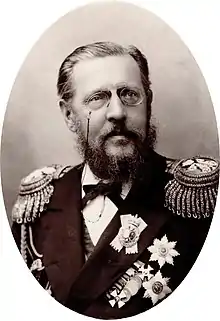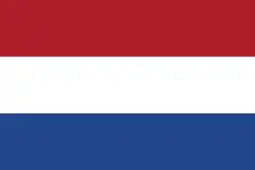Grand Duke Konstantin Nikolayevich of Russia
Grand Duke Konstantin Nikolayevich of Russia (21 September 1827 – 25 January 1892) was the second son of Nicholas I and his wife Charlotte of Prussia, and the Emperor's Viceroy of Poland from 1862 to 1863.
| Grand Duke Konstantin Nikolayevich | |||||
|---|---|---|---|---|---|
 | |||||
| Viceroy of the Kingdom of Poland | |||||
In office | 27 May 1862 – 19 October 1863 | ||||
Monarch | |||||
| Predecessor | Alexander von Lüders | ||||
| Successor | Friedrich Wilhelm Rembert von Berg | ||||
| Born | 21 September 1827 Winter Palace, Saint Petersburg, Russian Empire | ||||
| Died | 25 January 1892 (aged 64) Pavlovsk Palace, Pavlovsk, Russian Empire | ||||
| Burial | Grand Ducal Mausoleum, St. Petersburg, Russian Empire | ||||
| Spouse | Princess Alexandra of Saxe-Altenburg
(m. 1848) | ||||
| Issue Detail | Grand Duke Nicholas Konstantinovich Olga Konstantinovna, Queen of the Hellenes Vera Konstantinovna, Duchess Eugen of Württemberg Grand Duke Konstantin Konstantinovich Grand Duke Dimitri Konstantinovich Grand Duke Vyacheslav Konstantinovich | ||||
| |||||
| House | Holstein-Gottorp-Romanov | ||||
| Father | Nicholas I of Russia | ||||
| Mother | Charlotte of Prussia | ||||
| Religion | Russian Orthodox | ||||
The Grand Duke was a supporter of the liberal (sometimes referred to as "enlightened") bureaucrats during the period of his brother Alexander II's great reforms. He served as chairman of the Imperial Russian Geographical Society (founded in 1845). The Geographical Society was subordinate to the Ministry of Internal Affairs, which was home to a conspicuous number of liberal bureaucrats, including Nikolai Miliutin.
In addition to his support of and participation in the 1861 emancipation of the serfs, the Grand Duke also instituted reforms in the Imperial Russian Navy from 1854.
Konstantin's brother, Alexander II of Russia was supposed to have said: "Let the Poles have their own court and intrigues." Though the Grand Duke tried to show a liberal attitude towards the Poles, his efforts came too late and he was recalled with the outbreak of the January Uprising in 1863.
Children
Konstantin married Alexandra of Saxe-Altenburg in 1848; they had six children.
- Nicholas Konstantinovich (1850–1918)
- Olga Konstantinovna, Queen of the Hellenes (1851–1926)
- Vera Konstantinovna (1854–1912)
- Konstantin Konstantinovich (1858–1915)
- Dmitry Konstantinovich (1860–1919)
- Vyacheslav Konstantinovich (1862–1879); died of brain hemorrhage
At the end of the 1860s, Konstantin embarked on an affair, having an illegitimate daughter, Marie Condousso.
Konstantin had five illegitimate children with his mistress Anna Kuznetsova (1847–1922); they bore the last name Knyazev:
- Sergey Konstantinovich Knyazev (1873–1873)
- Marina Konstantinovna Knyazeva (8 December 1875 – 8 June 1941); m. 24 April 1894 Alexander Pavlovich Yershov (b. 6 July 1861), son of Gen. Pavel Yershov
- Anna Konstantinovna Knyazeva (16 March 1878 Saint Petersburg – 5 February 1920); (m.) 29 April 1898 in Saint Petersburg to Nikolay Nikolayevich Lyalin (15 August 1869 – 14 February 1920), son of Gen. Nikolay Lyalin, Military Governor of Helsingfors; their son was the Benedictine theologian Dom Clément Lialine; died of typhoid fever.
- Izmail Konstantinovich Knyazev (1879–1885); died of scarlet fever
- Lev Konstantinovich Knyazev (1883–1885); died of scarlet fever
Konstantin was the paternal great-great-grandfather of King Charles III of the United Kingdom, since his daughter Olga married George I of Greece, whose son Andrew married Alice Battenberg, and they became the parents of Philip, Charles' father. Through Constantine I of Greece, another son of Olga and George I, Konstantin is also the paternal great-great-grandfather of Queen Sofía of Spain, mother of King Felipe VI.
In Fiction
The Grand Duke is a central character in Act III of the novel Forty-Ninth[1] by Boris Pronsky and Craig Britton. In the book, Konstantin is the brains behind the liberal reforms of his brother, Russian Emperor Alexander II, as well as the sale of Alaska to the United States.
Honours
- National orders and decorations
- Knight of St. Andrew, 1827
- Knight of St. Alexander Nevsky, 1827
- Knight of the White Eagle, 1827
- Knight of St. Anna, 1st Class, 1827
- Knight of St. George, 4th Class, 1849
- Knight of St. Vladimir, 1st Class, 1853
- Knight of St. Stanislaus, 1st Class, 1865
- Foreign orders and decorations
 Sweden-Norway:[2]
Sweden-Norway:[2]
- Knight of the Seraphim, 12 June 1838
- Grand Cross of St. Olav, 11 August 1865
.svg.png.webp) Kingdom of Prussia:[3]
Kingdom of Prussia:[3]
- Knight of the Black Eagle, 14 June 1838; with Collar, 1857
- Pour le Mérite (military), 18 August 1849
- Grand Commander's Cross of the Royal House Order of Hohenzollern, 9 December 1865
 Denmark: Knight of the Elephant, 23 July 1844[4]
Denmark: Knight of the Elephant, 23 July 1844[4].svg.png.webp) Saxe-Weimar-Eisenach: Grand Cross of the White Falcon, 19 September 1846[5]
Saxe-Weimar-Eisenach: Grand Cross of the White Falcon, 19 September 1846[5].svg.png.webp)
.svg.png.webp)
.svg.png.webp) Ernestine duchies: Grand Cross of the Saxe-Ernestine House Order, October 1846[6]
Ernestine duchies: Grand Cross of the Saxe-Ernestine House Order, October 1846[6] Württemberg: Grand Cross of the Württemberg Crown, 1846[7]
Württemberg: Grand Cross of the Württemberg Crown, 1846[7] Kingdom of Hanover:[8]
Kingdom of Hanover:[8]
- Knight of St. George, 1847
- Grand Cross of the Royal Guelphic Order, 1847
 Netherlands: Knight of the Military William Order, 3rd Class, 30 August 1849;[9] Commander, 3 June 1857[10]
Netherlands: Knight of the Military William Order, 3rd Class, 30 August 1849;[9] Commander, 3 June 1857[10] Austrian Empire:[11]
Austrian Empire:[11]
- Grand Cross of the Royal Hungarian Order of St. Stephen, 1849
- Knight of the Military Order of Maria Theresa, 1849
.svg.png.webp) Kingdom of Bavaria: Knight of St. Hubert, 1849[12]
Kingdom of Bavaria: Knight of St. Hubert, 1849[12] Duchy of Parma:[13]
Duchy of Parma:[13]
- Grand Cross of St. Louis for Civil Merit, 1850
- Senator Grand Cross of the Constantinian Order of St. George, 1852
 Oldenburg: Grand Cross of the Order of Duke Peter Friedrich Ludwig, with Golden Crown, 9 March 1853[14]
Oldenburg: Grand Cross of the Order of Duke Peter Friedrich Ludwig, with Golden Crown, 9 March 1853[14] Grand Duchy of Hesse: Grand Cross of the Ludwig Order, 18 February 1857[15]
Grand Duchy of Hesse: Grand Cross of the Ludwig Order, 18 February 1857[15].svg.png.webp) Kingdom of Sardinia: Knight of the Annunciation, 26 February 1857[16]
Kingdom of Sardinia: Knight of the Annunciation, 26 February 1857[16].svg.png.webp) French Empire: Grand Cross of the Legion of Honour, May 1857[17]
French Empire: Grand Cross of the Legion of Honour, May 1857[17].svg.png.webp) Belgium: Grand Cordon of the Order of Leopold (military), 1 June 1857[18]
Belgium: Grand Cordon of the Order of Leopold (military), 1 June 1857[18].svg.png.webp) Baden:[19]
Baden:[19]
- Knight of the House Order of Fidelity, 1857
- Grand Cross of the Zähringer Lion, 1857
.svg.png.webp) Kingdom of Saxony: Knight of the Rue Crown, 1857[20]
Kingdom of Saxony: Knight of the Rue Crown, 1857[20].svg.png.webp) Two Sicilies: Grand Cross of St. Ferdinand and Merit[21]
Two Sicilies: Grand Cross of St. Ferdinand and Merit[21].svg.png.webp) Spain: Grand Cross of the Order of Charles III, 15 November 1880[22]
Spain: Grand Cross of the Order of Charles III, 15 November 1880[22]
Ancestry
| Ancestors of Grand Duke Konstantin Nikolayevich of Russia | |||||||||||||||||||||||||||||||||||||||||||||||||||||||||||||||||||||||||||||||||||||||||||||||||||||||||||||||||||||||||||||||||||||||||||||||||||||||||||||||||||||||||||||||||||||||||||||||||||||||||||||||||||||||||||||||||||||||||||||||||||||||||||||||||||||||||||||||||||||||||
|---|---|---|---|---|---|---|---|---|---|---|---|---|---|---|---|---|---|---|---|---|---|---|---|---|---|---|---|---|---|---|---|---|---|---|---|---|---|---|---|---|---|---|---|---|---|---|---|---|---|---|---|---|---|---|---|---|---|---|---|---|---|---|---|---|---|---|---|---|---|---|---|---|---|---|---|---|---|---|---|---|---|---|---|---|---|---|---|---|---|---|---|---|---|---|---|---|---|---|---|---|---|---|---|---|---|---|---|---|---|---|---|---|---|---|---|---|---|---|---|---|---|---|---|---|---|---|---|---|---|---|---|---|---|---|---|---|---|---|---|---|---|---|---|---|---|---|---|---|---|---|---|---|---|---|---|---|---|---|---|---|---|---|---|---|---|---|---|---|---|---|---|---|---|---|---|---|---|---|---|---|---|---|---|---|---|---|---|---|---|---|---|---|---|---|---|---|---|---|---|---|---|---|---|---|---|---|---|---|---|---|---|---|---|---|---|---|---|---|---|---|---|---|---|---|---|---|---|---|---|---|---|---|---|---|---|---|---|---|---|---|---|---|---|---|---|---|---|---|---|---|---|---|---|---|---|---|---|---|---|---|---|---|---|---|---|---|---|---|---|---|---|---|---|---|---|---|---|---|---|---|---|
| |||||||||||||||||||||||||||||||||||||||||||||||||||||||||||||||||||||||||||||||||||||||||||||||||||||||||||||||||||||||||||||||||||||||||||||||||||||||||||||||||||||||||||||||||||||||||||||||||||||||||||||||||||||||||||||||||||||||||||||||||||||||||||||||||||||||||||||||||||||||||
References
- Boris, Pronsky; Britton, Craig. Forty-Ninth. pp. 114–171. ISBN 9798201386238.
- Sveriges och Norges Statskalender (in Swedish), 1876, pp. 473, 717, retrieved 20 February 2019 – via runeberg.org
- "Königlich Preussische Ordensliste", Preussische Ordens-Liste (in German), Berlin, 1: 4, 11, 934, 1886
- Jørgen Pedersen (2009). Riddere af Elefantordenen, 1559–2009 (in Danish). Syddansk Universitetsforlag. p. 468. ISBN 978-87-7674-434-2.
- Staatshandbuch für das Großherzogtum Sachsen / Sachsen-Weimar-Eisenach (1859), "Großherzogliche Hausorden" p. 12
- Staatshandbücher für das Herzogtum Sachsen-Coburg und Gotha (1847), "Herzogliche Sachsen-Ernestinischer Hausorden" p. 27
- Württemberg (1869). Hof- und Staats-Handbuch des Königreichs Württemberg: 1869. p. 31.
- Hof- und Staats-Handbuch für das Königreich Hannover. Berenberg. 1854. pp. 33 63.
- "Militaire Willems-Orde: Romanov, Constantin Nicolajevitsj" [Military William Order: Romanov, Konstantin Nikolaevich]. Ministerie van Defensie (in Dutch). 30 August 1849. Retrieved 10 August 2020.
- "Militaire Willems-Orde: Romanov, Constantin Nicolajevitsj" [Military William Order: Romanov, Konstantin Nikolaevich]. Ministerie van Defensie (in Dutch). 3 June 1857. Retrieved 10 August 2020.
- "Ritter-Orden", Hof- und Staatshandbuch der Österreichisch-Ungarischen Monarchie, 1892, pp. 67, 69, retrieved 2 November 2019
- Bayern (1867). Hof- und Staatshandbuch des Königreichs Bayern: 1867. Landesamt. p. 9.
- Almanacco di corte (in Italian). 1858. pp. 240, 318. Retrieved 24 April 2019.
- Hof- und Staatshandbuch des Großherzogtums Oldenburg: 1879. Schulze. 1879. p. 31.
- Staatshandbuch für das Großherzogtum Hessen und bei Rhein (1879), "Großherzogliche Orden und Ehrenzeichen ", p. 10
- Luigi Cibrario (1869). Notizia storica del nobilissimo ordine supremo della santissima Annunziata. Sunto degli statuti, catalogo dei cavalieri. Eredi Botta. p. 116.
- M. & B. Wattel. (2009). Les Grand'Croix de la Légion d'honneur de 1805 à nos jours. Titulaires français et étrangers. Paris: Archives & Culture. p. 515. ISBN 978-2-35077-135-9.
- Ferdinand Veldekens (1858). Le livre d'or de l'ordre de Léopold et de la croix de fer. lelong. p. 213.
- Hof- und Staats-Handbuch des Großherzogtum Baden (1858), "Großherzogliche Orden" pp. 34, 48
- Staatshandbuch für den Freistaat Sachsen: 1865/66. Heinrich. 1866. p. 4.
- Napoli (Stato) (1857). Almanacco reale del Regno delle Due Sicilie: per l'anno ... Stamp. Reale. p. 406.
- "Real y distinguida orden de Carlos III", Guía Oficial de España (in Spanish), 1887, p. 158, retrieved 21 March 2019
- Chavchavadze, David. The Grand Dukes. Atlantic, 1989. ISBN 0-938311-11-5
- Ferrand, Jacques, Descendances naturelles des souverains et grands-ducs de Russie, de 1762 à 1910 : répertoire généalogique,1995.
- King, Greg, and Wilson, Penny. Gilded Prism. Eurohistory, 2006. ISBN 0-9771961-4-3
- Van Der Kiste, John. The Romanovs 1818–1959. Sutton Publishing, 1999. ISBN 0-7509-2275-3.
- Zeepvat, Charlotte. Romanov Autumn. Sutton Publishing, 2000. ISBN 0-7509-2739-9
External links
 Media related to Constantine Nikolaievich of Russia at Wikimedia Commons
Media related to Constantine Nikolaievich of Russia at Wikimedia Commons Works by or about Grand Duke Konstantin Nikolayevich of Russia at Wikisource
Works by or about Grand Duke Konstantin Nikolayevich of Russia at Wikisource